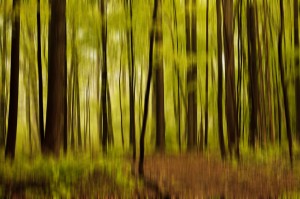Post by TWiP Contributor: Michelle Geoga
Photographers today have options for creating images that were unthinkable less than a decade ago-not so much the options, but the ease with which images can be manipulated.
While it has always been possible to manipulate in the wet darkroom and to employ in-camera techniques on film (see the work of Jerry Uelsmann), today photographers have a choice. Now that there is a digital darkroom option, with its allure of creative precision and relative ease of use–on a computer, with Photoshop, without chemicals, while sitting at a chair in a room with the lights on–the question is whether one process produces better results than the other. The answer, it depends.
Below is an image, taken with my 5DMarkII, a simple view of a forest with lots of upright trees (perfect for this illustration).
The first example is a straight image (shutter at 80, f4, ISO 800).
The second is the result of jerking the camera vertically (1/4 speed at f4, ISO 800).
The third is a duplicate of the straight shot with a filter applied (Motion Blur, 90 degrees, at 200).
The final shot is a heavily manipulated version, with cloned out tree sections, three overlays of different textures from my folder of textures and backgrounds, at different layer styles and set at different opacities, including the motion blur layer as a base.
Which image is better? Personally, for this image, I prefer the in-camera technique, but I can imagine a situation in which the Photoshop version is preferable. Also, I think that today (as in the past) the technique you develop might become an element of your vision and style. In any case, it's the possibilities that count. We are only limited by our imaginations.
Credits
[box]
Michelle Geoga – Michelle Geoga Photography
Website: http://www.michellegeoga.com
[/box]
Which image is better? Personally, for this image, I prefer the in-camera technique, but I can imagine a situation in which the Photoshop version is preferable. Also, I think that today (as in the past) the technique you develop might become an element of your vision and style. In any case, it's the possibilities that count. We are only limited by our imaginations.




